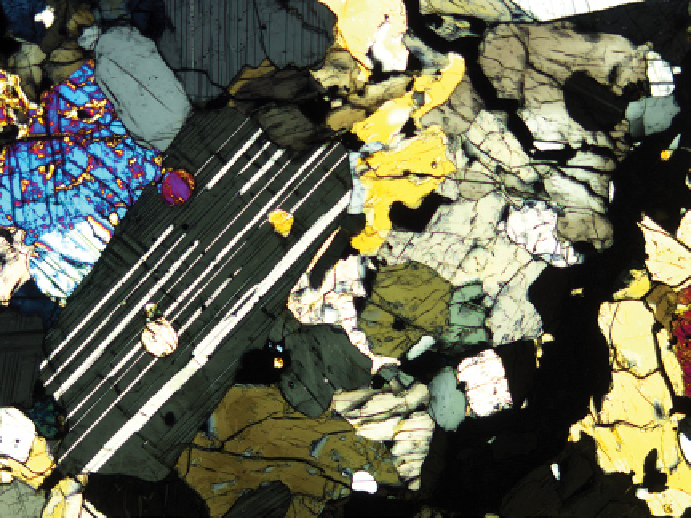Geology Reference
In-Depth Information
Figure 5.11.
Plutonic angrite lEW 86010 was the first member of the group to have a “basaltic” mineralogy (olivine, high-Ca clino-
pyroxene, plagioclase), which allowed for combined long-lived and short-lived chronometers to be studied, pinning the absolute age
of magmatism to early solar system time-scales of CAI and chondrule formation. Image is 2.5 mm across.
the petrologic evolution of its parent asteroid. The late
1980s saw the recovery of three small angrites from
Antarctica, which resulted in a fuller understanding of
petrogenesis on their parent asteroid. (The large
D'Orbigny stone, found in 1979, only became known to
meteoriticists in 2001.) Angrites were recently reviewed,
and the synopsis of their petrologic and compositional
characteristics given here is derived from
Keil
[2012] and
references therein.
The angrites are mafic igneous and metaigneous rocks
that are divided petrologically into two types, volcanic
and plutonic, based on textures and mineral compositions.
Plutonic members are medium- to coarse-grained with
hypdiomorphic granular or polygonal-granular textures
and equilibrated or modestly zoned mineral compositions.
Volcanic angrites have porphyritic to ophitic textures and
contain highly zoned minerals. Porphyritic members are
olivine-phyric and contain coarse olivine phenocrysts or
xenocrysts. Angrites contain the unusual silicate mineral
assemblage of Ca-rich olivine, Al-Ti-diopside-hedenbergite
(hereafter calcic pyroxene), kirschsteinite, and nearly
Na-free anorthite (Figure 5.11). Oxide phases are herc-
ynitic spinel and ulvöspinel. Plutonic angrite Angra dos
Reis is an outlier of the group, with a modal mineralogy
of ~93 vol.% calcic pyroxene, ~6 vol.% olivine plus
kirschsteinite, and is plagioclase-free. (Plagioclase found
in mineral separates of Angra dos Reis is likely a labora-
tory contaminant; see
Mittlefehldt et al.
, 1998.] All other
angrites contain between approximately 20 and 40 vol.%
plagioclase. Calcic pyroxene varies from ~24 to ~58 vol.%,
while olivine plus kirschsteinite vary from ~13 to
~52 vol.%. Other phases typically are never more than
~1 vol.% each.
In porphyritic volcanic angrites, olivine is highly zoned
from core mg#s 85-90 and ln (larnite) <0.5 mole% for
coarse grain cores to mg# <2, ln 15-20 mole% for grain
rims and groundmass grains. The nature of the coarse
olivine is uncertain, and the most magnesian cores are
thought to be xenocrysts [
Mikouchi et al.
, 1996]. The
cores of olivine grains in ophitic angrites are not as mag-
nesian, with mg#s ~65. Core compositions of calcic
pyroxene have mg#s of ~60-65 for volcanic angrites and
~75 for plutonic angrites. The TiO
2
and Al
2
O
3
contents
are high with ~1.5 and ~9.0 wt.% in the cores of volcanic
angrite calcic pyroxenes, and ~2.2 and 10.0 wt.% in plu-
tonic angrites. Kirschsteinite is subcalcic in volcanic
angrites with ln of 30-35 mole% and mg# <10, while it
is calcic in plutonic angrites with ln 47-48 mole% and
mg# of 53 for Angra dos Reis and 21 for lEW 86010.
Plagioclase is nearly pure anorthite, An
>99
. Hercynitic
spinel and ulvöspinel compositions require that some of
the Fe be ferric in order to satisfy charge balance, indi-
cating a higher oxygen fugacity for their parent magma
than typical for basaltic achondrites.
Angrites have unusual major element compositions
that are distinct from those of other asteroidal basalts

